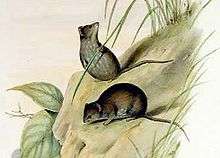Planigale
| Planigales | |
|---|---|
 | |
| Common planigales | |
| Scientific classification | |
| Kingdom: | Animalia |
| Phylum: | Chordata |
| Class: | Mammalia |
| Order: | Dasyuromorphia |
| Family: | Dasyuridae |
| Subfamily: | Sminthopsinae |
| Tribe: | Planigalini Archer, 1982 |
| Genus: | Planigale Troughton, 1928 |
| Type species | |
| Planigale brunneus Troughton, 1928 (= Phascogale ingrami Thomas, 1906) | |
| Species | |
The genus Planigale are small carnivorous marsupials found in Australia and New Guinea. It is the only genus in the tribe Planigalini of the subfamily Sminthopsinae. There are five species:
- Paucident planigale, Planigale gilesi
- Long-tailed planigale, Planigale ingrami
- Common planigale, Planigale maculata
- New Guinean planigale, Planigale novaeguineae
- Narrow-nosed planigale, Planigale tenuirostris
Species Identification
Planigales are the smallest of all marsupials with some members of this carnivorous group weighing less than 5 grams. Being small, nocturnal and secretive, they are rarely seen; however, they are generally common in many parts of the arid interior of Western Australia. Their small size and puzzling nature makes them difficult to tell apart, but with recent work being undertaken at the Western Australian Museum on the Planigales collections it has been possible to recognise two species new to science. Although yet to be formally described and published, these species are easiest to tell apart externally by the shape of their footpads, consequently the Museum has taken a series of footpad photos to aid in identification of the species comprising this genus.[1]
References
- Groves, C.P. (2005). Wilson, D.E.; Reeder, D.M., eds. Mammal Species of the World: A Taxonomic and Geographic Reference (3rd ed.). Baltimore: Johns Hopkins University Press. pp. 36–37. ISBN 0-801-88221-4. OCLC 62265494.